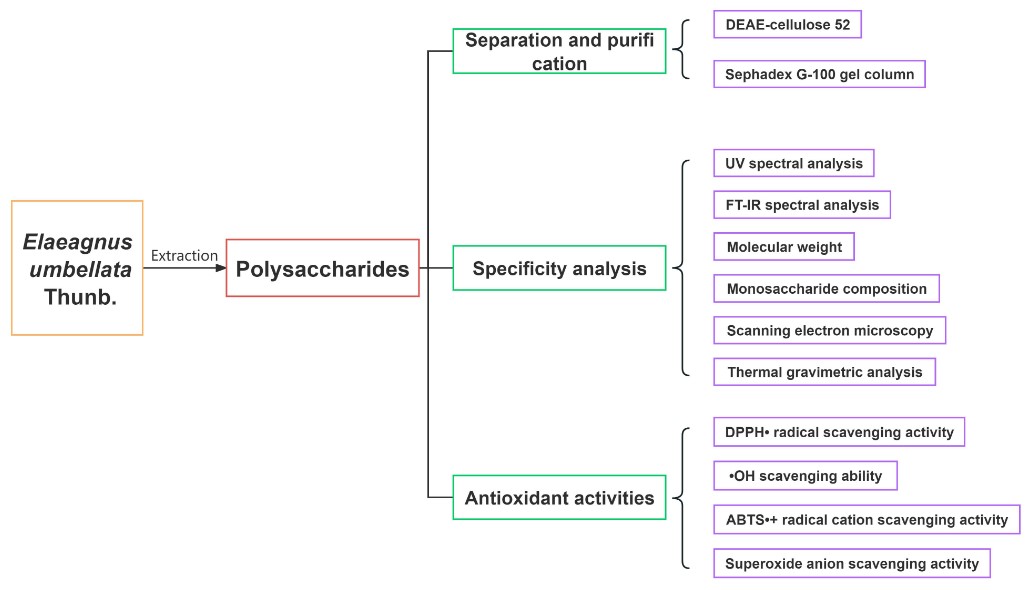Polysaccharides with Antioxidant Activity Identification Service
Polysaccharides derived from natural products are of considerable interest in antioxidant activities. Particularly, for the antioxidant systems, polysaccharides are considered as effective free radical scavengers and reducing agents in most of the reports. As a leading specialist in glycoprotein design, synthesis, and characterization of complex carbohydrates, Creative Biolabs is happy to introduce our top-quality service for the identification of polysaccharides with antioxidant activity.
Introduction of Polysaccharide
Polysaccharide is a high molecular weight polymer, consisting of at least ten monosaccharides mutually joined by glycosidic linkages. The glycosyl moiety together with the hydroxyl group of another sugar unit formed the glycosidic linkages. Unlike protein and nucleic acid, the structure of polysaccharide is much more complicated because of the differences in the composition of monosaccharide residues, glycosidic linkages, sequence of sugar units, degrees of polymerization, and branching point. Apart from those, other factors, such as differences of cultivars, origins, and batches, or even extraction methods and fraction procedures are evidenced to have a significant influence on the physicochemical and structural properties of polysaccharides.
 Fig.1 The separation, structure identification, and antioxidant activity of Elaeagnus umbellata polysaccharides.1, 2
Fig.1 The separation, structure identification, and antioxidant activity of Elaeagnus umbellata polysaccharides.1, 2
Antioxidant Activity of Polysaccharides
Recent research has confirmed that polysaccharides possess wide-ranging beneficial therapeutic effects and health-promoting properties. Especially, seaweed-derived polysaccharides (including alginate, fucoidan, carrageenan, laminaran, and agar) are widely distributed in biomedical and biological applications, such as tissue engineering, wound healing, drug delivery and biosensor. Moreover, there is growing interest in further pursuing the potential bioactivities of diverse polysaccharides. In particular, most of these polysaccharides emerged as an important agent of antioxidants. The antioxidant potentials of polysaccharides are not determined by a single factor but a combination of several related factors, such as physicochemical properties or structural features.
Identification of Polysaccharides with Antioxidant Activity at Creative Biolabs
Polysaccharides have been demonstrated to have multiple bioactivities, including immunomodulating, anticancer, antimicrobial, hypocholesterolemic, and hypoglycemic effects. Some polysaccharides have been reported as a kind of effective antioxidants, playing a critical role in protecting against oxidation damage in living organisms. On the other side, many diseases, such as asthma, chronic obstructive pulmonary disease, diabetes, inflammation, cardiovascular diseases, and myocardial infarction, are reported to associate with oxidative stress.
Creative Biolabs has established a unique platform by assembling top-class scientific experts and substantial experience in the identification of polysaccharide with antioxidant activity. We employ two in vitro methods, hydrogen atom transfer-based methods, and single electron transfer based methods to evaluate the antioxidant activities. Other assays, such as superoxide radical scavenging, hydrogen peroxide scavenging, and singlet oxygen quenching can be performed to evaluate the scavenging ability for oxidants.
Highlights
-
A variety of tailored biopanning strategies
-
Highly professional Ph.D. level scientists
-
Competitive and affordable price
-
Reliability and information security
Seasoned scientists at Creative Biolabs are glad to apply our special expertise to help our worldwide customers with their cutting-edge projects related to polysaccharides with antioxidant activity. We offer high-quality custom services by adjusting protocols to meet even the most specific requirements. For more detailed information, please feel free to contact us or directly send us an inquiry.
References
-
Zhang, Jinhua, et al. "The separation, purification, structure identification, and antioxidant activity of Elaeagnus umbellata polysaccharides." Molecules 28.18 (2023): 6468.
-
Under Open Access license CC BY 4.0, without modification.
For Research Use Only.
Related Services

 Fig.1 The separation, structure identification, and antioxidant activity of Elaeagnus umbellata polysaccharides.1, 2
Fig.1 The separation, structure identification, and antioxidant activity of Elaeagnus umbellata polysaccharides.1, 2



